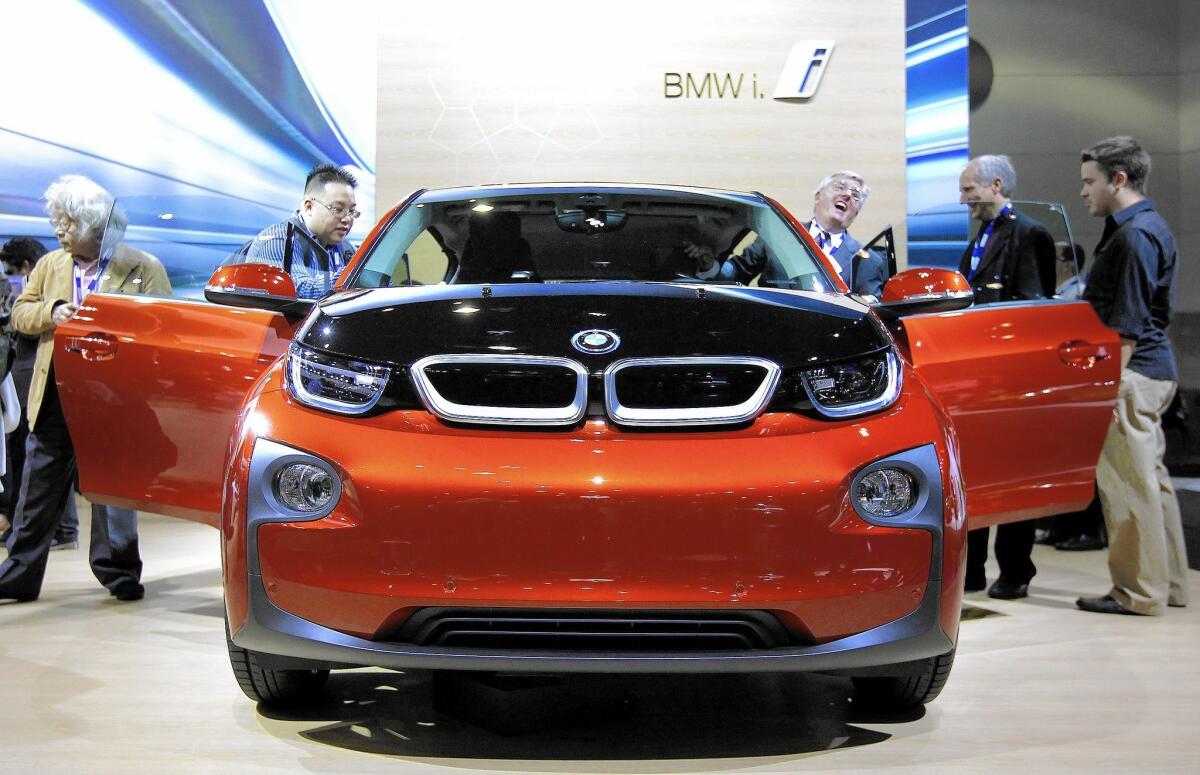California bill would reduce sales tax on green cars

- Share via
The California Legislature is considering a bill that would cut the state sales tax on green cars by more than half in an effort to spur sales of clean vehicles.
The bill, sponsored by Assemblyman Phil Ting (D-San Francisco), would reduce the sales tax on new clean vehicles to 3.06%, down from the current 7.5%. The reduction would apply to electric cars, hydrogen fuel cell vehicles, plug-in hybrids and compressed natural gas vehicles.
Ting’s original bill stalled in 2013 primarily because of concerns over funding. But the legislator says the state’s improved financial health and Gov. Jerry Brown’s repeated calls for reductions in greenhouse gases and petroleum use have increased prospects for its passage.
“We think the timing is perfect right now,” said Ting. “This is the quickest, most effective way to incentivize consumers. There’s no bureaucracy to deal with, no rebate to mail in.”
Ting said revenue collected under California’s cap-and-trade program could now provide crucial dollars to offset the lost tax revenue from the proposed tax cut. Funds from the cap-and-trade program were not available when the bill was initially proposed in 2013.
The cap-and-trade fund is at $969 million as of Feb. 18, according to the California Air Resources Board, though much of that money has already been allocated for the 2014-15 budget.
The state holds quarterly auctions in which carbon emissions credits are sold to corporations and municipalities that emit carbon into the atmosphere. The program was expanded at the beginning of 2015 to include companies that produce transportation fuels. Thus, the number of available allowances has nearly doubled, and in the most recent auction this month, a broad swath of companies snatched up credits.
Ting’s proposed legislation, which would be in effect from 2016 to 2020, could cost California more than $92 million a year in lost tax revenue, based on the roughly 60,000 plug-in hybrid and electric vehicles that were sold in California in 2014 with a national average transaction price of $34,725 per vehicle. The bill could also help drive sales to meet state mandates, Ting said. Brown signed an executive order in 2012 that called for 1.5 million zero-emission vehicles on California’s roads by 2025.
But so far, fewer than 134,000 such vehicles are registered in the state as of September 2014, according to the most recent data from the Department of Motor Vehicles. Nationally, the demand also remains low: Electric vehicles accounted for just 0.4% of all vehicles sales in 2014, according to IHS Automotive.
The governor has also called for cutting in half the amount of petroleum used in cars and trucks in California by 2030.
Several automakers leading the green car market applauded the move, saying the bill provides an “easy to understand” incentive that will bring in new customers to the showroom looking to save money.
“We know that purchase incentives work,” said Shad Balch, a spokesman for General Motors, which produces the Chevy Volt plug-in hybrid and has announced plans to bring the all-electric Bolt to market in the coming years. “Anything that makes it easier for the customer to understand and is part of the deal in the showroom just adds to the benefit.”
Nissan, maker of the all-electric Leaf, also supports the bill.
“When incentives like this are available, it definitely increases consideration for electric vehicles like the Leaf,” said Brian Brockman, a company spokesman. States that offer tax rebates or other incentives like carpool access generally have the strongest adoption of EVs, Brockman said.
The bill needs to clear several committees before heading to the Assembly floor for a vote later this year. The bill currently has no major opposition in the Assembly. The only hurdle will be the funding, Ting said.
But some auto analysts were cautious about the impact of such a bill.
“Yes, this could have an effect on sales,” said Tom Libby, an analyst at IHS Automotive. “Will it double sales? No. The demand for both hybrid and electric vehicles is not growing.”
With consumers remaining tepid about green vehicles, auto companies have turned to other methods of boosting fuel economy, Libby said. These include cutting the vehicles’ weight; using materials such as aluminum, high-strength steel and carbon fiber; engine technologies such as turbocharging and direct injection; and transmissions with as many as 10 speeds.
“I don’t think it’s necessarily a bad thing,” said John O’Dell, a senior writer at Edmunds.com, pointing out that the green car market is still new enough that it’s going to take continued subsidies to promote these vehicles until their cost comes down and demand goes up.
Although the proposed bill could eventually mean more clean vehicles on the used-car market at more affordable prices, initially it may only benefit higher-income buyers, O’Dell said.
“It’s still tending to reward people who probably are less in need of a reward. Poorer people aren’t going to be able to afford these cars unless they give them away.”
david.undercoffler@latimes.com







